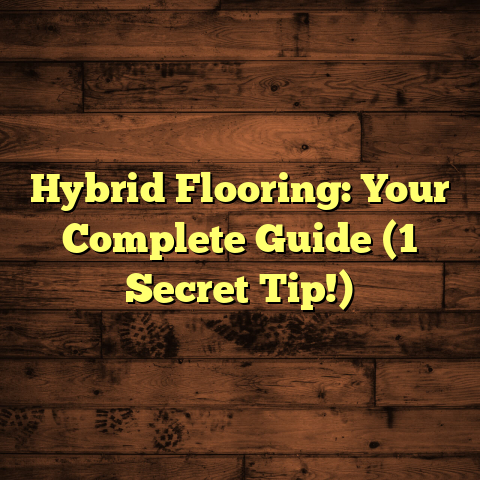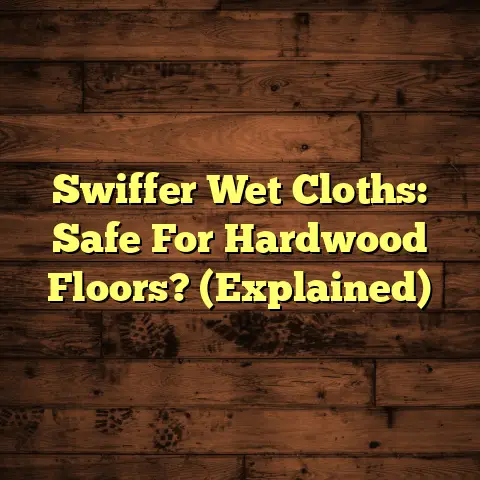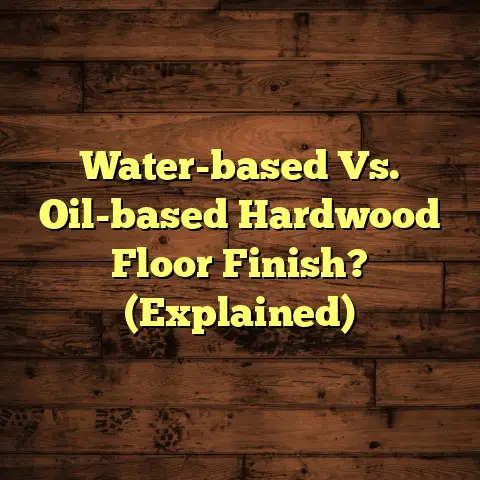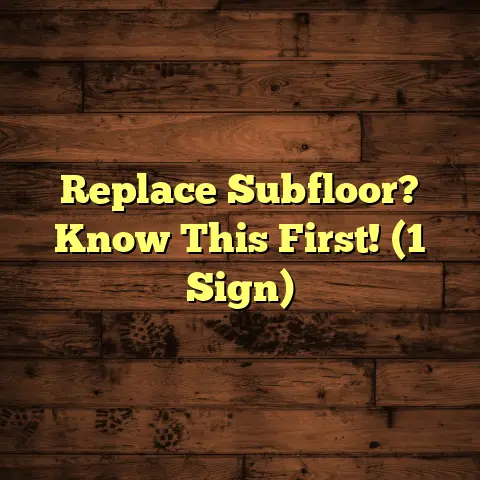Best Gym Flooring: Non-Porous? (6 Options Now!)
Ever wonder about the unsung hero of your gym?
I’m talking about the FLOOR!
It’s more than just something to walk on.
It’s a crucial element for safety, performance, and hygiene.
I’ve been in the flooring game for over 15 years, and I’ve seen it all.
From rickety wooden floors to cutting-edge, high-tech surfaces.
Let’s take a trip back in time.
Imagine ancient Greece, where gymnasia were born.
They weren’t strutting around on fancy rubber floors, were they?
Nope! They were wrestling on dirt or grass!
Fast forward to modern times, and we’ve got a whole universe of flooring options.
But today, we’re laser-focused on one thing: non-porous flooring.
Why?
Because in a gym environment, where sweat, spills, and heavy equipment are part of the daily grind, non- porous is the way to go.
Ready to dive in?
Let’s explore the world of non- porous gym flooring!
Section 1: Understanding
Non-Porous Flooring
So, what exactly is non-porous flooring?
Simply put, it’s flooring that doesn’t absorb liquids or trap dirt and grime.
Think of it like this: a sponge is porous.
It soaks up everything.
A glass tabletop?
Non-porous.
Liquids just bead up on the surface.
Now, why is this important for a gym?
Well, imagine a porous floor soaking up sweat and bacteria.
Yuck!
That’s a recipe for odors, mold, and a generally unhygienic environment.
Non-porous flooring, on the other hand, is much easier to clean and disinfect.
It prevents the growth of nasty stuff, keeping your gym cleaner and healthier.
Let’s break down the key differences between porous and non-porous materials:
| Feature | Porous Flooring | Non-Porous Flooring |
|---|---|---|
| Water Absorption | High | Very Low |
| Hygiene | Difficult to Clean | Easy to Clean |
| Maintenance | More Demanding | Less Demanding |
| Bacteria Growth | Higher Risk | Lower Risk |
| Stain Resistance | Lower | Higher |
See the difference?
It’s night and day!
I’ve seen gyms transform from smelly, bacteria-ridden zones to clean, inviting spaces simply by switching to non-porous flooring.
Trust me, it makes a huge difference!
Section 2: The Benefits of
Non-Porous Gym Flooring
Okay, so we know what non-porous flooring is.
But what are the real benefits for your gym?
Let’s break it down:
-
Hygiene: This is huge! Non-porous surfaces are a breeze to clean.
A quick mop with a disinfectant, and you’re good to go.
No more worrying about sweat and bacteria seeping into the floor! * Durability: Gyms are high- traffic areas.
You need flooring that can withstand a beating.
Non-porous materials are generally very durable and can handle heavy equipment, dropped weights, and constant foot traffic. * Safety: Slip and fall injuries are a major concern in gyms.
Non-porous flooring, especially when properly textured, can provide excellent traction, reducing the risk of accidents. * Aesthetic Appeal: Let’s be honest, looks matter!
Non-porous flooring comes in a wide variety of colors, styles, and finishes.
You can create a gym that not only functions well but also looks amazing.
I remember one gym owner who was struggling with a persistent mold problem in his weight room.
He switched to epoxy flooring, and the problem vanished!
Plus, the new floor looked fantastic, and his members loved it.
It was a win-win-win!
Section 3: Top 6 Non-Porous
Gym Flooring Options
Alright, let’s get down to the nitty- gritty.
Here are six of the best non-porous gym flooring options on the market today:
1. Vinyl Flooring
-
Overview: Vinyl flooring is a synthetic material made from polyvinyl chloride (PVC).
It’s known for its durability, water resistance, and versatility. * Pros: Relatively inexpensive, easy to install, comes in a wide variety of styles and colors, and is highly water-resistant. * Cons: Can be susceptible to dents and scratches from heavy equipment, may not be as comfortable underfoot as some other options. * Ideal Use Cases: General fitness areas, aerobics studios, locker rooms. * Maintenance Tips: Regular mopping with a neutral cleaner.
Avoid harsh chemicals or abrasive cleaners.
I’ve seen vinyl used effectively in smaller gyms where budget is a major concern.
It’s a great way to get a clean, durable floor without breaking the bank.
2. Rubber Flooring
-
Overview: Rubber flooring is made from recycled or synthetic rubber.
It’s known for its shock absorption, noise reduction, and durability. * Types: Rolled rubber, rubber tiles, interlocking rubber tiles. * Pros: Excellent shock absorption, reduces noise, durable, slip- resistant, and comfortable underfoot. * Cons: Can be more expensive than vinyl, may have a rubbery odor initially, can be difficult to install properly. * Recommended Thickness: Varies depending on the application.
For weight rooms, I recommend at least 3/8 inch. * Installation Methods: Glue-down, interlocking, or loose-lay. * Ideal Use Cases: Weight rooms, cardio areas, CrossFit boxes.
Rubber flooring is my go-to choice for weight rooms.
It can handle the impact of dropped weights and provides a comfortable surface for workouts.
3. Laminate Flooring
-
Overview: Laminate flooring is a multi-layer synthetic flooring product fused together with a lamination process.
It simulates wood, tile, or stone with a photographic applique layer under a clear protective layer. * Pros: Cost-effective, easy to install, realistic appearance, durable. * Cons: Not as water-resistant as vinyl or rubber, can be slippery when wet, may not be suitable for high-impact areas. * Comparison: Cheaper than hardwood, more durable than carpet, but less water-resistant than vinyl. * Best Practices: Ensure a level subfloor, use a moisture barrier, follow manufacturer’s instructions for installation. * Ideal Use Cases: Low-impact areas like yoga studios or office spaces within a gym.
While laminate isn’t my top pick for high-traffic gym areas, it can be a good option for lower-impact zones where you want a more aesthetic look.
4. Epoxy Flooring
-
Overview: Epoxy flooring is a resin-based coating applied over concrete.
It creates a seamless, durable, and chemical-resistant surface. * Application: Requires proper surface preparation, mixing of epoxy components, and careful application. * Customization: Available in a wide range of colors, patterns, and finishes.
You can even embed logos or designs into the epoxy. * Pros: Extremely durable, chemical- resistant, easy to clean, seamless, and aesthetically pleasing. * Cons: Can be expensive, requires professional installation, and can be slippery when wet (requires anti-slip additives). * Repair and Longevity: Can last for many years with proper maintenance.
Minor scratches and chips can be repaired. * Ideal Use Cases: High-impact areas, weight rooms, commercial gyms.
Epoxy is a beast!
It’s incredibly durable and can withstand just about anything you throw at it.
It’s a great choice for gyms that see a lot of heavy use.
5. Polyurethane Flooring
- Characteristics: Polyurethane flooring is a resilient and flexible material that offers excellent abrasion resistance and impact resistance.
- Benefits: Chemical resistance, easy to clean, durable, and comfortable underfoot.
- Suitability: Suitable for a wide range of gym activities, including weightlifting, aerobics, and general fitness.
- Pros: More flexible than epoxy, better UV resistance, good for areas with temperature fluctuations.
- Cons: Can be more expensive than epoxy, may require specialized installation.
- Ideal Use Cases: Areas where flexibility and impact resistance are important, such as dance studios or high-impact training zones.
Polyurethane is a bit like epoxy’s cousin.
It offers many of the same benefits, but with added flexibility.
It’s a good choice for areas where you need a floor that can move and flex.
6. Concrete Flooring
- Overview: Polished and sealed concrete is a durable and low- maintenance flooring option.
- Advantages: Durable, low maintenance, modern aesthetic.
-
Finishes and Coatings: Can be stained, polished, and sealed to enhance its appearance and performance.
Consider adding a non-slip coating for safety. * Pros: Very durable, long-lasting, cost-effective in the long run, and can be customized with stains and finishes. * Cons: Can be hard and cold underfoot, may require sealing to prevent staining, and can be slippery when wet. * Ideal Use Cases: Large open gyms, CrossFit boxes, industrial- style fitness centers.
Concrete is a classic!
It’s tough, durable, and can look amazing with the right finishes.
It’s a great choice for gyms that want a modern, industrial vibe.
Section 4: Comparing the
Six Options
Okay, so we’ve covered a lot of ground.
Let’s take a step back and compare these six options side-by-side:
| Flooring Type | Cost | Installation | Durability | Hygiene | Ideal Use |
|---|---|---|---|---|---|
| Vinyl | Low | Easy | Moderate | Excellent | General fitness, aerobics, locker rooms |
| Rubber | Moderate | Moderate | Excellent | Good | Weight rooms, cardio areas, CrossFit boxes |
| Laminate | Low-Moderate | Easy | Moderate | Good | Yoga studios, office spaces |
| Epoxy | High | Professional | Excellent | Excellent | High-impact areas, weight rooms, commercial gyms |
| Polyurethane | High | Professional | Excellent | Excellent | Dance studios, high-impact training zones |
| Concrete | Moderate | Moderate | Excellent | Good | Large open gyms, CrossFit boxes, industrial style |
As you can see, each option has its own strengths and weaknesses.
The best choice for your gym will depend on your specific needs, budget, and aesthetic preferences.
Think about the following factors:
- Cost: How much are you willing to spend?
- Installation: Can you DIY, or will you need professional help?
- Durability: How much wear and tear will the floor be subjected to?
- Hygiene: How important is it to have a floor that’s easy to clean and disinfect?
- Aesthetics: What kind of look are you going for?
Section 5: Case Studies and
Real-World Applications
Let’s take a look at some real-world examples of gyms that have successfully implemented these flooring options:
-
Case Study 1: The Budget-Friendly Fitness Center
A small, independent fitness center in a suburban area chose vinyl flooring for its main workout area and locker rooms.
The owner was on a tight budget but needed a durable and easy-to-clean surface.
Vinyl proved to be a perfect fit.
The owner reported that the vinyl floor has held up well to daily use and is easy to maintain. * Case Study 2: The High-Impact CrossFit Box
A CrossFit box in an urban environment opted for rubber flooring throughout its facility.
The owner needed a floor that could withstand the impact of dropped weights and provide a safe surface for athletes.
Rubber flooring was the obvious choice.
The owner has been extremely happy with the performance of the rubber floor, noting that it has significantly reduced noise and vibration. * Case Study 3: The Upscale Commercial Gym
A large, commercial gym in a downtown location chose epoxy flooring for its weight room and polyurethane flooring for its dance studio.
The owner wanted a durable, aesthetically pleasing floor that would impress members.
Epoxy and polyurethane delivered on both fronts.
The owner has received numerous compliments on the floors and has found them to be easy to maintain.
I’ve personally worked on projects where gym owners have seen a significant increase in member satisfaction after upgrading their flooring.
A clean, safe, and aesthetically pleasing floor can make a huge difference in the overall gym experience.
Conclusion
Choosing the right flooring for your gym is a big decision.
It’s an investment that will impact the safety, hygiene, and overall appeal of your facility.
Non-porous flooring is a must-have for any gym that wants to maintain a clean and healthy environment.
The six options we’ve discussed today offer a range of benefits and cater to different needs and preferences.
Take the time to assess your unique gym requirements and consider the information we’ve provided.
With a little research and planning, you can choose the perfect flooring that will help your gym thrive!
Good luck, and happy lifting!





